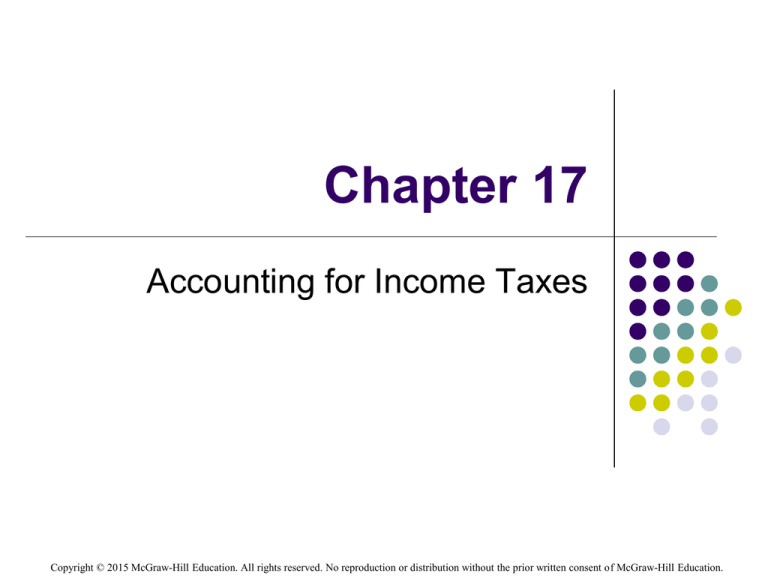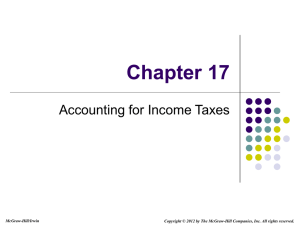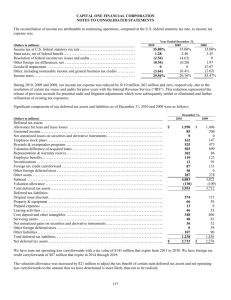
Chapter 17
Accounting for Income Taxes
Copyright © 2015 McGraw-Hill Education. All rights reserved. No reproduction or distribution without the prior written consent of McGraw-Hill Education.
Learning objectives
1.
Explain the objectives behind FASB ASC Topic 740,
Accounting for Income Taxes, and the income tax
provision process
2.
Calculate the current and deferred income tax expense
or benefit components of a company’s income tax
provision
3.
Recall what a valuation allowance represents and
describe the process by which it is determined
17-2
Learning objectives
4.
5.
Explain how a company accounts for its uncertain
income tax positions under ASC 740 (a codification of
FASB Interpretation (FIN) No. 48, Accounting for
Uncertainty in Income Taxes)
Recognize the different components of a company’s
disclosure of its income tax accounts in the financial
statements and footnotes and comprehend how a
company computes and discloses the components of
its “effective tax rate”
17-3
Objectives of “Accounting for Income
Taxes” and Income Tax Provision Process
The income tax provision includes
Current year taxes payable or refundable
Any changes to future income taxes payable or
refundable that result from differences in the timing of
when an item is reported on the tax return compared
to the financial statement
A company records these future income taxes
payable or refundable on its balance sheet as
Deferred tax liability
Deferred tax asset
17-4
Objectives of “Accounting for Income
Taxes” and Income Tax Provision Process
Objectives of ASC 740
ASC 740 applies only to:
Income taxes levied by the U.S. federal government
U.S. state and local governments
Non-U.S. (“foreign”) governments
The FASB defines an income tax as a tax based on
income, which excludes property taxes, excise taxes,
sales taxes, and value-added taxes.
Companies report non-income taxes as expenses
in the computation of their net income before taxes
17-5
Objectives of “Accounting for Income
Taxes” and Income Tax Provision Process
Steps in determining the income tax provision
Adjust pretax income for permanent differences
Identify all temporary differences and carryforwards
Calculate the current income tax expense or benefit
Recognize deferred tax assets and liabilities
Evaluate the need for a valuation allowance for
deferred tax assets
Calculate the deferred income tax expense or benefit
Determine changes to liabilities for uncertain tax
positions
17-6
Objectives of “Accounting for Income
Taxes” and Income Tax Provision Process
Income Tax Provision Process
Compute the two components of the income tax
provision
Current
Deferred
Combine the two components to produce the total
income tax provision
Formula
17-7
Calculate Current and Deferred Income
Tax Expense or Benefit Component
Adjust Pretax Net Income for All Permanent
Differences
Permanent differences - Differences that appear only on
the income statement or tax return, but not on both
A company does not take permanent differences into
account in computing its deferred tax assets and
liabilities
Permanent differences usually affect a company’s
effective tax rate and appear as part of its reconciliation
of its effective tax rate with the statutory U.S. tax rate
17-8
Calculate Current and Deferred Income
Tax Expense or Benefit Components
17-9
Calculate Current and Deferred Income
Tax Expense or Benefit Components
Identify All Temporary Differences and Tax
Carryforward Amounts
Temporary differences commonly arise in four instances
Revenues or Gains that are taxable after they are recognized in
Financial Income
Expenses or Losses that are deductible after they are recognized
in Financial Income
Revenues or Gains that are taxable before they are recognized in
Financial Income
Expenses or Losses that are deductible before they are
recognized in Financial Income
17-10
Calculate Current and Deferred Income
Tax Expense or Benefit Components
17-11
Calculate Current and Deferred Income
Tax Expense or Benefit Components
Identifying Taxable and Deductible Temporary
Differences
Taxable Temporary Difference
Initially favorable gives rise to a taxable temporary difference
Taxable temporary differences generally arise when
Revenues or gains are taxable after they are recognized in net
income
Expenses or losses are deductible on the tax return before
they reduce net income
17-12
Determining Whether a Valuation
Allowance is Needed
Evaluate the Need for a Valuation Allowance for
Gross Deferred Tax Assets
A valuation allowance is required if it is more likely
than not some or all of the deferred tax asset will not
be realized in the future.
ASC 740 identifies four sources of potential future
taxable income, two of which are objective and other
two are subjective.
17-13
Determining Whether a Valuation
Allowance is Needed
Objective sources
Future Reversals of Existing Taxable Temporary
Differences
If the reversing taxable temporary differences provide sufficient
future taxable income to absorb the reversing deductible
temporary differences, the company does not record a valuation
allowance against the deferred tax asset.
17-14
Determining Whether a Valuation
Allowance is Needed
Subjective sources
Expected future taxable income exclusive of
reversing temporary differences and carryforwards
A company might support its predictions of future taxable income
with evidence of existing contracts or a sales backlog that will
produce enough taxable income to realize the deferred tax asset
when it reverses.
17-15
Determining Whether a Valuation
Allowance is Needed
Tax Planning Strategies
Includes sale and leaseback of operating assets
Changing inventory accounting methods
Refraining from making voluntary contributions to the company
pension plan
Electing to capitalize certain expenditures rather than deduct
them currently
Sale of noncore assets
Electing the alternative depreciation system
17-16
Determining Whether a Valuation
Allowance is Needed
Negative Evidence That a Valuation Allowance Is
Needed
ASC 740 requires that a company consider negative as
well as positive evidence in determining whether it is
more likely that a deferred tax asset will not be realized
in the future.
Negative evidence includes
Cumulative (book) losses in recent years (usually 36 quarters)
A history of net operating (capital) losses and credits expiring
unused
17-17
Accounting for Uncertainty in Income
Tax Positions
FAS 109 provided no specific guidance on how to
deal with uncertain tax positions.
Companies generally applied the principles of
FAS 5, Accounting for Contingencies, to uncertain
tax positions.
The objective of FIN 48 (codified in ASC 740-10)
was to provide a uniform approach to recording
and disclosing tax benefits resulting from tax
positions that are considered to be uncertain.
17-18
Accounting for Uncertainty in Income
Tax Positions
ASC 740-10 applies to all tax positions accounted
for in accordance with ASC 740, including:
Previously filed positions
Expected filing positions
Decisions not to file tax returns in a particular jurisdiction
Decisions to exclude potentially taxable income
Choices made in classifying a transaction as tax-exempt
or taxable
17-19
Accounting for Uncertainty in Income
Tax Positions
ASC 740-10 applies a two step process in
evaluating tax positions
Recognition process
Company first determines if it is more likely than not that its tax
position on a particular account will be sustained on IRS
examination based on its technical merits
Company then determines the amount it expects to be able to
recognize
17-20
Accounting for Uncertainty in Income
Tax Positions
Measurement process
Requires the company to make a cumulative probability
assessment of all likely outcomes of the audit and litigation
process
A company recognizes the amount that has a greater than 50
percent probability of being sustained on examination and
subsequent litigation
The amount not recognized is recorded as a liability on the
balance sheet
Interest and Penalties - may be included in the provision or
reported as a deduction in computing pretax income
17-21
Financial Statement Disclosure and
Corporation's Effective Tax Rate
Balance Sheet Classification
ASC 740 requires companies (public and private) to
disclose their deferred tax assets and liabilities on their
balance sheets and classify them as either current or
noncurrent
ASC 740 permits companies to net deferred tax assets
and liabilities based on their classification and present
the net amount on the balance sheet
ASC 740 does not permit netting of deferred tax assets
and liabilities that are attributable to different tax
jurisdictions
17-22





